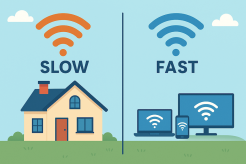What Counts as Data Usage? Breaking Down Every Online Activity

In today’s connected world, understanding what actually counts as data usage is more important than ever. Whether you're using mobile internet, a broadband connection, or a shared Wi-Fi network, every online activity you engage in—streaming, gaming, browsing, or even syncing files—burns through data. But how much exactly? If you've ever been shocked by a data cap warning or overage charge, it's time to break it all down and take control of your usage.
Let’s explore every digital action that eats up your data, from streaming 4K videos to scrolling through memes, and how tools like data usage calculators can help you stay on top of it.
Understanding Data Usage: What Is It?
Data usage refers to the amount of digital information sent or received over your internet connection. Every time your device communicates with the internet—whether it’s loading a web page, watching a video, or updating an app—it consumes data.
Measured in megabytes (MB) or gigabytes (GB), data usage is typically tracked monthly by your internet or mobile service provider.
Why Tracking Data Usage Matters
If your internet plan includes a data cap, going over it can lead to:
Throttled speeds
Extra charges
Service interruptions
Even unlimited plans often have "soft" data caps where your speed slows after a certain threshold.
That's why understanding what activities use the most data is crucial—so you can adjust your habits or upgrade your plan if needed.
Common Online Activities and Their Data Usage
Here’s a breakdown of the most popular internet activities and how much data they typically use.
1. Video Streaming
Streaming is one of the most data-intensive activities. The resolution matters big time.
Standard Definition (SD): ~1 GB per hour
High Definition (HD): ~3 GB per hour
4K Ultra HD: ~7-10 GB per hour
Love Netflix, YouTube, or Disney+? You might want to keep a close eye on your streaming habits.
👉 You can get an accurate picture with this data usage calculator tool that estimates streaming consumption across different resolutions and services.
2. Music Streaming
Apps like Spotify, Apple Music, or Pandora consume much less data:
Normal quality: ~40-50 MB/hour
High quality: ~100-150 MB/hour
It adds up if you're streaming all day, but it’s generally lighter than video.
3. Web Browsing and Social Media
While casual browsing doesn’t use much data, some media-heavy sites do:
Basic web browsing: ~150-200 MB/hour
Social media with video (e.g., Instagram Reels, TikTok): ~500 MB/hour
Comparing data usage across popular apps and services is a smart way to plan your usage. This detailed guide explains how platforms like Facebook, YouTube, and TikTok stack up.
4. Video Calls and Conferencing
Whether it’s Zoom, Google Meet, or FaceTime, video calling can eat up quite a bit of data depending on quality:
Standard video call: ~540 MB/hour
HD video call: ~1.2 GB/hour
Turn off HD or use voice-only options when you're watching your data.
5. Online Gaming
Gaming doesn't use as much data as people assume—but game downloads and updates do.
Playing games online: ~40-300 MB/hour
Downloading a game: ~40-100 GB
Game updates: ~1-10 GB each
If you game regularly, especially on consoles or PCs, be prepared for spikes in data usage.
6. Cloud Services and File Transfers
Syncing files with services like Google Drive or iCloud can add up fast.
Uploading/downloading large files: depends on file size
Automatic backups: can use 1-5 GB/day if not optimized
Disable automatic syncs on metered networks to save data.
How to Track and Manage Your Data Usage
Awareness is half the battle. Here’s how you can better manage your monthly data:
Use a Data Usage Calculator
To get a ballpark estimate of your usage, try the mobile data usage calculator. Just plug in your daily habits—streaming, browsing, gaming—and see how it all adds up.
Avoid Overages With Smart Tools
Want to stop worrying about unexpected charges? Learn how to use a data usage calculator to avoid overages. These tools help you plan smarter and possibly adjust your usage before you get hit with a fee.
Tips to Reduce Data Usage Without Compromising Experience
You don’t always have to stop doing what you love. Try these simple adjustments:
Lower video streaming quality on YouTube or Netflix
Download content (like Netflix movies or Spotify playlists) on Wi-Fi
Use data saver modes on apps like Instagram and Chrome
Turn off auto-play videos on social media
Schedule backups for nighttime when you’re on Wi-Fi
Unlimited Isn’t Always Unlimited
Be wary of so-called "unlimited" plans. Most have limits on high-speed data or prioritize traffic once you cross a usage threshold. Always read the fine print and compare packages.
Business Use: Monitoring Your Office's Data Footprint
Remote work and cloud collaboration are the norm, but they also increase data consumption:
Frequent Zoom meetings
Large file sharing
VPN connections
Businesses can also benefit from usage calculators to predict bandwidth needs and choose the right plan accordingly.
Final Thoughts: Know Your Data to Own Your Internet
Data usage can seem invisible, but it’s affecting your bill, your speed, and your experience every single day. By understanding what counts as data usage—from binge-watching your favorite shows to uploading work files—you gain the power to optimize your digital life.
Use tools like the online data calculator, read up on mobile data estimation, and plan smarter. Your wallet (and your Wi-Fi) will thank you.
Related Posts

Fri, Dec 19, 2025 4:36 AM
SafetyEasy Ways to Keep Your Video Calls Secure
Learn practical ways to secure your video conferencing apps and protect your calls from unwanted access, cyberattacks, and privacy risks.

Fri, Dec 19, 2025 2:39 AM
Internet Bundles Broadband Deals TechnologyWhy Internet Bills Keep Going Up (And Why It Feels Constant)
Why do internet bills keep rising? Learn how ISP fees, limited competition, and pricing strategies quietly increase broadband costs.

Thu, Dec 18, 2025 3:59 AM
cheap internet dealsViasat (Exede) Satellite Internet Plans & Pricings
Explore Viasat (Exede) satellite internet plans, pricing, and speeds. Learn about availability, equipment, technology, and tips for rural and remote areas.

Thu, Dec 18, 2025 2:14 AM
SafetySimple Online Safety Tips Anyone Can Follow
Learn simple, practical ways to stay safe online—even if you’re not tech-savvy. Protect your data, avoid scams, and improve digital security with easy habits.

Wed, Dec 17, 2025 2:22 AM
WifiWhy’s My Internet Slower Than What I’m Paying For?
Paying for fast internet but getting slow speeds? Learn the real reasons your internet doesn’t match your plan and how to fix performance issues.